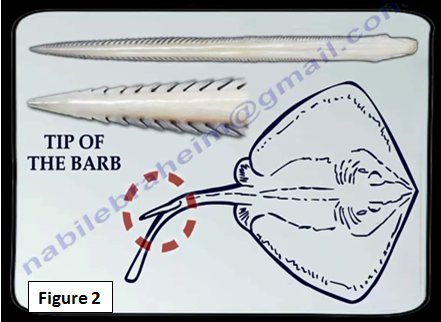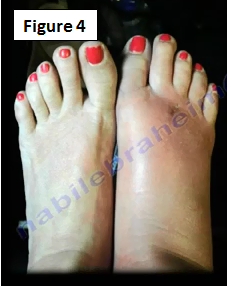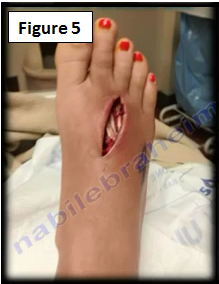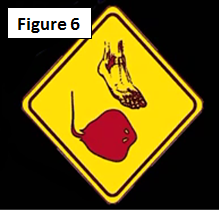Dr. Nabil Ebraheim would like to thank his employee Cherie Martzke, for her contribution to this article.
Most stingrays have one or more barbed stings on the tail, which are used in self-defense. They will not attack humans but they will defend themselves when threatened, especially when stepped on (Figure 1).
Stingrays cause around 1,500 injuries per year and are caused by puncture from their strong serrated, boney spines or barbs. The tail contains a sheath that will discharge venom once it is ruptured (Figure 2).
If you are stung by a stingray, clean the injury with soap and water. Make sure the spine is completely removed and use hot water (45°C or 110°F) in order to decrease the pain caused by the poison (Figure 3). Venom from the stingray is thermolabile, which means that it will decompose with heat.
The foot or leg is the most common area affected by these injuries due to stepping on the stingray which causes the tail to be thrust upward and forward.
Effects of the venom include constriction of the blood vessels and tissue necrosis. The patient will feel extreme pain and may experience edema and swelling (Figure 4). Sometimes a fragment from the barb may be stuck inside the wound and this may cause an infection.
Surgical exploration may be needed and the use of ultrasound is helpful in detecting the barb fragment (Figure 5). The patient will typically recover with a positive outcome. Fatalities from there types of injuries are rare, but are possible, such as the case of Steve Irwin.
In order to prevent stingray injuries, it is recommended that before entering the water you look for posted warning signs (Figure 6). Before entering murky water, poke around with a stick. Keep away from or be aware of stingray gathering places, especially under piers and shallow water. Wear protective water shoes, boots or stingray guards. Never swim over moving stingrays. Slide your feet along the bottom as the stingray will notice your presence and swim away.
A Patient Testimony
While working on this article, Cherie Martzke, an employee of Dr. Nabil Ebraheim, volunteered to share her story. We have been given permission by Cherie Martzke to publish her testimony.
My name is Cherie Martzke. In April 2013, I was stung by a stingray while vacationing on the Gulf coast of Florida. I was initially treated with antibiotic therapy, unfortunately this failed. I developed an abscess at the site and required surgery. I live in Toledo and I am an employee at UTMC. Dr. Ebraheim immediately recognized the severity of the infection and took me to surgery. He performed two I&D procedures as well as a wound vac application. He continued with ACell therapy. As seen in documented photos the infection took most of my tissues exposing several tendons. He kept reassuring me that he would heal me and save my foot. Dr. Ebraheim provided me with amazing surgical care and follow up care. In time, he was able to grow enough new tissue to close my foot! Today my foot is completely healed. I have no issues regarding pain, scar tissue, or range of motion. I am able to run, exercise, and wear all types of footwear. I credit Dr. Ebraheim's advanced knowledge and surgical skill for saving my foot and ultimately giving me my way of life back. I will forever be grateful for him.
For more information, visit my YouTube Channel:
https://www.youtube.com/user/nabilebraheim
Dr. Nabil Ebraheim would like to thank his employee Cherie Martzke, for her contribution to this article.





